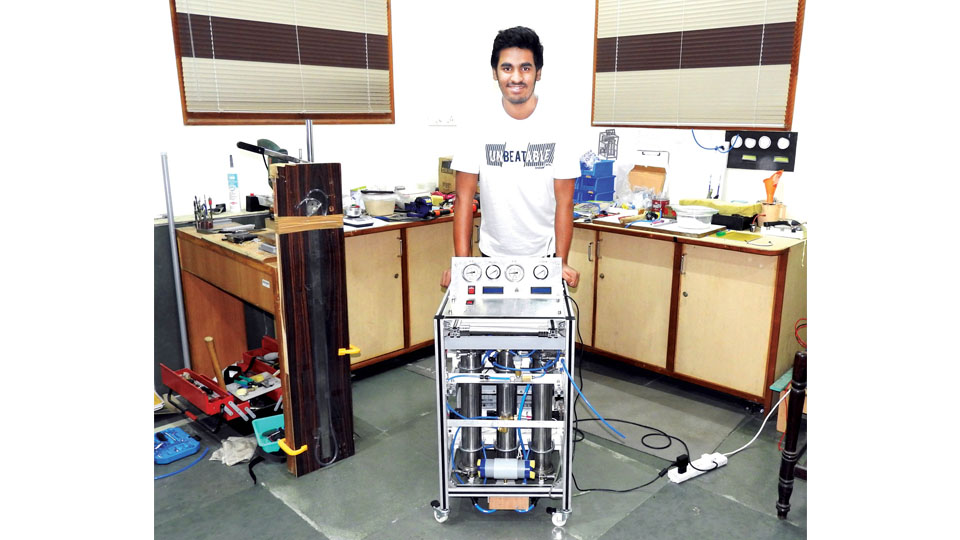- Pandemic-need innovation: OxiPlant is configurable, scalable and flexible
- Generates continuous oxygen; better than costly imported concentrators
During the COVID pandemic, especially in the killer first wave and the second wave, shortage of medical oxygen was one of the major crises experienced in most of the hospitals across the country that led to the loss of many lives.
Hospitals, especially in Bengaluru and cities like Mysuru struggled to keep up with demand for oxygen, particularly during surges and the demand was driven by severe cases that required supplying extra oxygen to patient’s lungs.
This severe shortage of medical oxygen and subsequent deaths moved an engineering student to such a level that he single-handedly created an oxygen plant in eight months — from conceptualisation till the end product.
Called OxiPlant, the machine is way better and more efficient than the imported ones and also affordable if manufactured in India, says Tejas P. Karanji, a first year B.Tech student of Electronics and Communication at PES University in Bengaluru.
Son of T.N. Pandarinath, an IITian (Mechanical Engineering) and Vani S. Mysore, the 19-year-old Tejas has a Mysuru connection as his mother hails from city. His grandmother and aunt stay at Vontikoppal.
OxiPlant can produce up to 94.05 percent pure oxygen and can be used in homes, hospitals as well as industries. Notably, it produces continuous oxygen and does not need a break or cooling period unlike other oxygen concentrators after a four-hour usage.
“Before I conceptualised OxiPlant, I interacted with a couple of doctors who told me that the imported oxygen concentrators were not functioning to the optimum level and there were several drawbacks. One being the four-hour window but the patients needed continuous supply of oxygen and I had to solve this drawback,” Tejas told Star of Mysore.
Working of OxiPlant
According to Tejas, OxiPlant works on the principle of Pressure Swing Adsorption (PSA). The device consists of two specially fabricated stainless cylinders, each filled with a measured quantity of a specially made material called Zeolite. Dry, cooled and pressurised air is alternatively passed through these cylinders. Nitrogen molecules get thermodynamically adsorbed by the zeolite crystals, allowing oxygen to flow out as the desired product.
“While this principle has been well-known for over a century, the challenge lies in engineering a solution around the principle. Building OxiPlant involved mechanical design and fabrication, pneumatics circuits with proper understanding of pressure, temperature and flow controls, and more critically electronics which control, monitor, and automatically operate the entire oxygen production cycle,” he says.
Its USP
The unique selling point (USP) of OxiPlant and its differentiation from commonly available concentrators lies in its configurability, flexibility, scalability, and monitorability. It can continuously produce 11 litres of oxygen per minute (LPM). In the Low Flow Rate (LFR), it can generate 5 to 6 LPM and in the High Flow Rate (HFR), it can generate 11 LPM.
It is configurable to support many alternative processes such as PSA, Vacuum Swing Adsorption (VSA) and Vacuum Pressure Swing Adsorption (VPSA) etc. OxiPlant is flexible to support production of Oxygen or Nitrogen or other gases. It is scalable to higher throughput up to about 20 LPM. It is monitorable as many temperatures, pressure and flow probes can be hooked up to provide valuable performance data that would form the basis of plant tuning, he adds.
Safety features added
OxiPlant is 0.6 metres deep, half-metre wide and 0.7 metres high. Another USP of this plant developed by Tejas is that it is not noisy, bulky and does not have a condensation problem unlike the China-made concentrators.
Multiple safety features have been added to OxiPlant. The prototype has the potential to be developed into a marketable product and it will cost anywhere between Rs. 35,000 and Rs. 40,000 while the same capacity machine, if imported, will cost over Rs. 1 lakh.
“I am planning to publish about OxiPlant innovation in reputed scientific journals and I am sure that someone will be willing to produce it on a large scale. I am open to sharing the details and knowledge. We need to be battle-ready to face future pandemics,” Tejas says.








Recent Comments